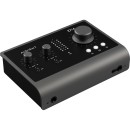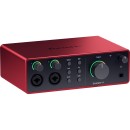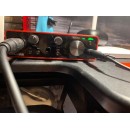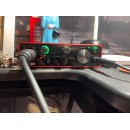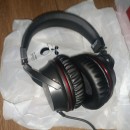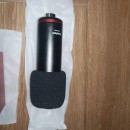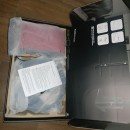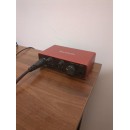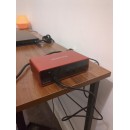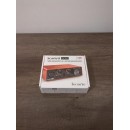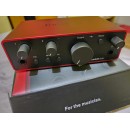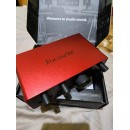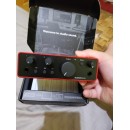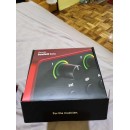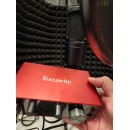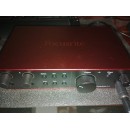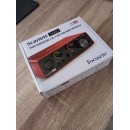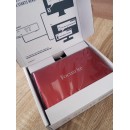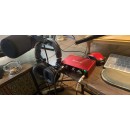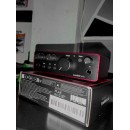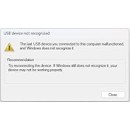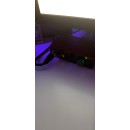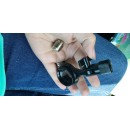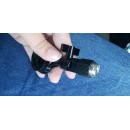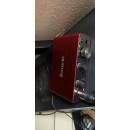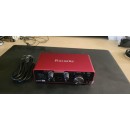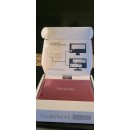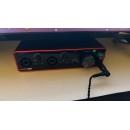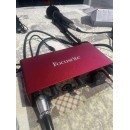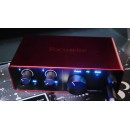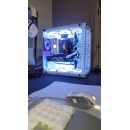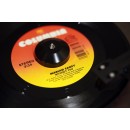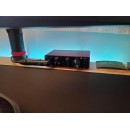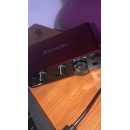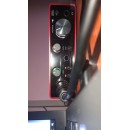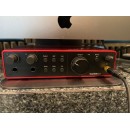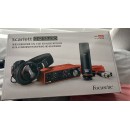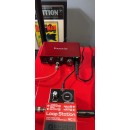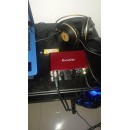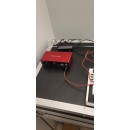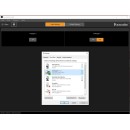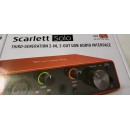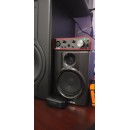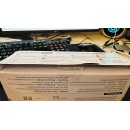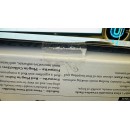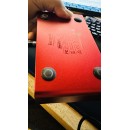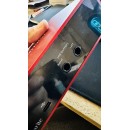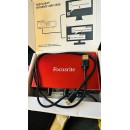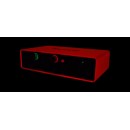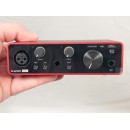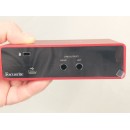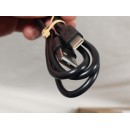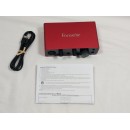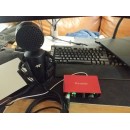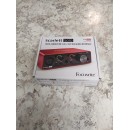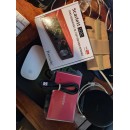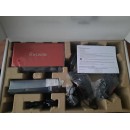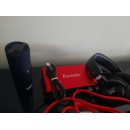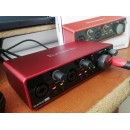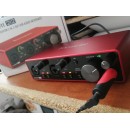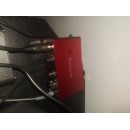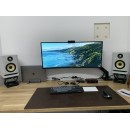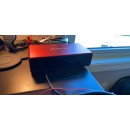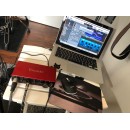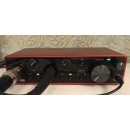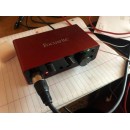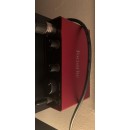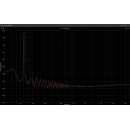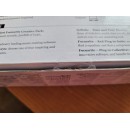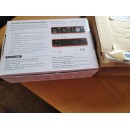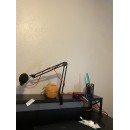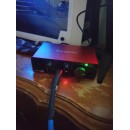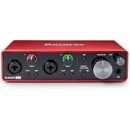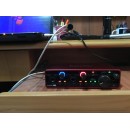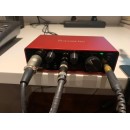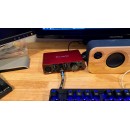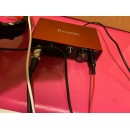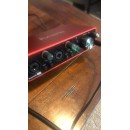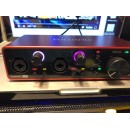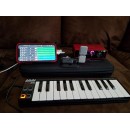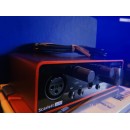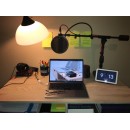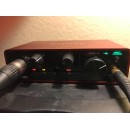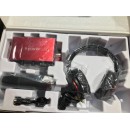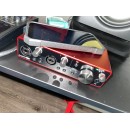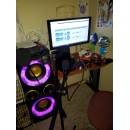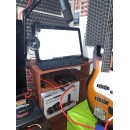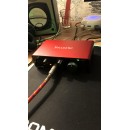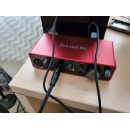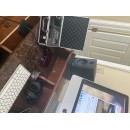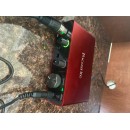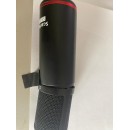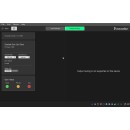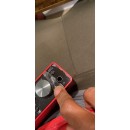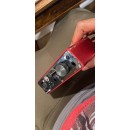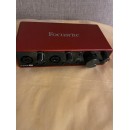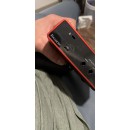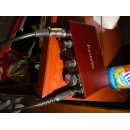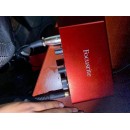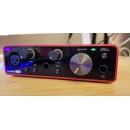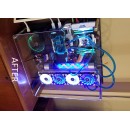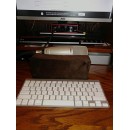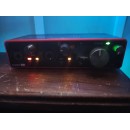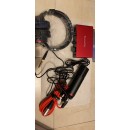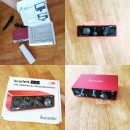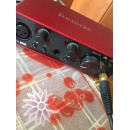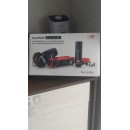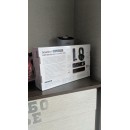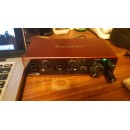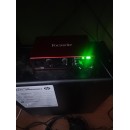Audient iD14 MKII vs Focusrite Scarlett 4i4 (4th Gen): Comprehensive Comparison
The Focusrite Scarlett 4i4 (4th Generation) is known for its pristine audio quality and user-friendly interface. It features four inputs, including two Scarlett mic preamps with switchable Air mode to emulate the sound of Focusrite’s classic ISA mic preamp, and two additional line inputs. The device provides four balanced line outputs and MIDI I/O, making it versatile for various recording and playback scenarios. The Scarlett 4i4 also boasts high-performance 24-bit/192kHz AD-DA converters, ensuring clear and detailed sound capture and playback. Its USB-C connectivity ensures fast data transfer and low latency, which is essential for real-time audio processing. Additionally, the Scarlett 4i4 comes with a comprehensive software package, including Ableton Live Lite and a range of Focusrite’s own software tools, making it an excellent choice for those looking to get started quickly with a professional setup.
On the other hand, the Audient iD14 MKII is celebrated for its premium build quality and exceptional audio performance. It features two Audient Console mic preamps, known for their transparency and low noise, along with JFET instrument inputs that provide a warm, tube-like sound. The iD14 MKII offers ten inputs and six outputs, including an ADAT input for expanding the interface with additional preamps. This makes it highly scalable for more extensive recording setups. The device also includes a ScrollControl feature, which allows the volume knob to be used for controlling various parameters within your DAW, enhancing workflow efficiency. The iD14 MKII supports 24-bit/96kHz audio resolution, ensuring high-fidelity recordings. Its robust metal chassis and intuitive design make it a durable and professional choice for studio environments. Additionally, it includes software such as the ARC Creative Hub, providing users with a range of creative tools and plugins to enhance their production capabilities.
In summary, both the Focusrite Scarlett 4i4 4th Gen and the Audient iD14 MKII are excellent audio interfaces that offer high-quality audio and a range of features suitable for different recording needs. The Scarlett 4i4 is ideal for those seeking a versatile, easy-to-use interface with comprehensive software support, while the iD14 MKII is perfect for users who prioritize premium build quality, expandability, and advanced workflow features. Your choice between the two will ultimately depend on your specific requirements and preferences in a recording interface.
Specifications, Advantages, and Disadvantages
| User Rating Based on Analysis of Reviews | |
|---|---|
|
Show More |
| Pros: | |
|---|---|
|
|
| Cons: | |
|---|---|
|
|
| Find Best Price | Find Best Price |
| Key Specs | |
|---|---|
| Channels of I/O | |
| Analog: 2 Inputs / 6 Outputs at 96 kHz Digital: 8 Input / 0 Output at 48 kHz |
Analog: 4 Inputs / 4 Outputs at 192 kHz |
| Maximum Sampling Rate | |
| 96 kHz / 24-Bit | 192 kHz / 24-Bit |
| Number of Microphone Inputs | |
| 2 Preamps | 2 |
| Analog Audio I/O | |
| 2x Combo XLR-1/4" TRS Balanced Mic/Line Input 1x 1/4" TRS Unbalanced Hi-Z Input (Front Panel) 4x 1/4" TRS Balanced Line/Monitor Output 1x 1/4" TRS Unbalanced Headphone Output (Front Panel) 1x 1/8" / 3.5 mm TRS Unbalanced Headphone Output (Front Panel) |
2x Combo XLR-1/4" 3-Pin Balanced/Unbalanced Mic/Line/Hi-Z Input (Front Panel) 2x 1/4" TRS Balanced/Unbalanced Line Input 4x 1/4" TRS Balanced/Unbalanced Line/Monitor Output 1x 1/4" TRS Headphone Output (Front Panel) |
| Digital Audio I/O | |
| 1x TOSLINK Optical ADAT / S/PDIF Input (S/MUX Support) | |
| Host Connection | |
| 1x USB-C | 1x USB-C |
| OS Compatibility | |
| macOS 10.11.6 or Later macOS 11.1 or Later Windows 7 or Later |
macOS Windows |
| Power Requirements | |
| USB Bus Power | USB Bus Power, USB Power Adapter (Not Included) |
Firstly, in terms of channels of I/O, the Focusrite Scarlett 4i4 offers 4 analog inputs and 4 analog outputs at a maximum sampling rate of 192 kHz. In contrast, the Audient iD14 MKII provides 2 analog inputs and 6 analog outputs at a maximum sampling rate of 96 kHz. Additionally, the Audient iD14 MKII includes 8 digital inputs via TOSLINK Optical ADAT / S/PDIF at 48 kHz, which the Scarlett 4i4 does not feature.
Regarding the number of microphone inputs, both interfaces are equipped with 2 preamps. However, the Audient iD14 MKII has an additional 1/4" TRS unbalanced Hi-Z input on the front panel, which is not present on the Scarlett 4i4.
The analog audio I/O configurations also differ. The Focusrite Scarlett 4i4 includes 2 combo XLR-1/4" 3-pin balanced/unbalanced mic/line/Hi-Z inputs on the front panel, 2x 1/4" TRS balanced/unbalanced line inputs, 4x 1/4" TRS balanced/unbalanced line/monitor outputs, and 1x 1/4" TRS headphone output on the front panel. The Audient iD14 MKII, on the other hand, features 2 combo XLR-1/4" TRS balanced mic/line inputs, 1x 1/4" TRS unbalanced Hi-Z input (front panel), 4x 1/4" TRS balanced line/monitor outputs, 1x 1/4" TRS unbalanced headphone output (front panel), and an additional 1/8" / 3.5 mm TRS unbalanced headphone output on the front panel.
For digital audio I/O, the Audient iD14 MKII outshines the Scarlett 4i4 with its TOSLINK Optical ADAT / S/PDIF input that supports S/MUX, whereas the Scarlett 4i4 lacks any digital audio I/O options.
Both interfaces connect to the host via USB-C and are compatible with macOS and Windows operating systems. The Audient iD14 MKII supports macOS 10.11.6 or later and macOS 11.1 or later, along with Windows 7 or later, while the Scarlett 4i4 supports both macOS and Windows without specifying particular versions.
Finally, both units are powered via USB bus power. However, the Scarlett 4i4 also mentions the option of using a USB power adapter (not included), providing an alternative power source.
| General | |
|---|---|
| Channels of I/O | |
| Analog: 2 Inputs / 6 Outputs at 96 kHz Digital: 8 Input / 0 Output at 48 kHz |
Analog: 4 Inputs / 4 Outputs at 192 kHz |
| Maximum Sampling Rate | |
| 96 kHz / 24-Bit | 192 kHz / 24-Bit |
| Number of Microphone Inputs | |
| 2 Preamps | 2 |
| Input Level Adjustment | |
| 2x Knob | 2x Knob |
| Expansion Slots | |
The Focusrite Scarlett 4i4 offers a higher maximum sampling rate of 192 kHz at 24-bit, compared to the Audient iD14 MKII's maximum sampling rate of 96 kHz at 24-bit. This makes the Scarlett 4i4 more suitable for applications requiring higher resolution audio. It provides 4 analog inputs and 4 analog outputs, whereas the Audient iD14 MKII only offers 2 analog inputs but compensates with 6 analog outputs. The Scarlett 4i4 does not include built-in DSP or expansion slots, and it features 2 microphone inputs without built-in microphones, controlled by 2 input level adjustment knobs.
On the other hand, the Audient iD14 MKII, while having a lower maximum sampling rate, delivers a more extensive input/output configuration with its 8 digital inputs at 48 kHz, making it a versatile choice for setups that require multiple digital inputs. It also includes 2 microphone preamps and 2 input level adjustment knobs, with no built-in DSP or expansion slots. The larger number of outputs (6 analog) on the iD14 MKII provides more flexibility for monitoring and routing audio signals.
In summary, the Focusrite Scarlett 4i4 excels in providing higher sampling rates and a balanced analog input/output configuration, making it ideal for high-resolution audio recording. The Audient iD14 MKII, while offering a lower sampling rate, stands out with its additional digital inputs and greater number of analog outputs, catering to users needing more extensive routing options and digital input compatibility.
| Signal Processing | |
|---|---|
| Gain/Trim Range | |
| Mic/Hi-Z Inputs: 58 dB Hi-Z Inputs: 40 dB |
Mic/Line Inputs: Up to +69 dB Hi-Z Inputs: 62 dB |
In contrast, the Audient iD14 MKII Desktop 10x6 USB Type-C Audio Interface provides a gain/trim range that is somewhat less extensive. The mic/Hi-Z inputs offer 58 dB of gain, and the Hi-Z inputs provide a maximum of 40 dB gain. This indicates that while the Audient iD14 MKII can accommodate a range of input levels, it may not offer the same level of flexibility as the Focusrite Scarlett 4i4 in terms of handling extremely low or high-output sources.
Additionally, the Audient iD14 MKII lacks certain features that may be crucial for some users. It does not include a pad, which can be useful for attenuating high-level signals to avoid distortion. The interface also lacks a high-pass filter, which is beneficial for eliminating low-frequency noise. Furthermore, the absence of solo/mute functionality might limit its utility in more complex recording or mixing scenarios where these features are often necessary to isolate or silence specific channels quickly.
In summary, the Focusrite Scarlett 4i4 4th Generation stands out with its higher gain/trim range for both mic/line and Hi-Z inputs, making it more flexible for a wider array of recording needs. The Audient iD14 MKII, while offering solid performance, lacks some features such as a pad, high-pass filter, and solo/mute options, which might be a consideration for users who require these functionalities.
| Connectivity | |
|---|---|
| Analog Audio I/O | |
| 2x Combo XLR-1/4" TRS Balanced Mic/Line Input 1x 1/4" TRS Unbalanced Hi-Z Input (Front Panel) 4x 1/4" TRS Balanced Line/Monitor Output 1x 1/4" TRS Unbalanced Headphone Output (Front Panel) 1x 1/8" / 3.5 mm TRS Unbalanced Headphone Output (Front Panel) |
2x Combo XLR-1/4" 3-Pin Balanced/Unbalanced Mic/Line/Hi-Z Input (Front Panel) 2x 1/4" TRS Balanced/Unbalanced Line Input 4x 1/4" TRS Balanced/Unbalanced Line/Monitor Output 1x 1/4" TRS Headphone Output (Front Panel) |
| Phantom Power | |
| 48 V ± 4 V, Selectable On/Off (Selectable on Individual Inputs) | 48 V, Selectable On/Off |
| Digital Audio I/O | |
| 1x TOSLINK Optical ADAT / S/PDIF Input (S/MUX Support) | |
| Host Connection | |
| 1x USB-C | 1x USB-C |
| Host Connection Protocol | |
| USB 3.0 / 3.1/3.2 Gen 1 | USB 2.0 |
| USB (Non-Host) | |
| 1x USB-C (Power Input) | |
| Sync I/O | |
| Network I/O | |
| MIDI I/O | |
|
1x DIN 5-Pin Input 1x DIN 5-Pin Output |
|
The Focusrite Scarlett 4i4 (4th Generation) comes equipped with a variety of analog audio I/O options. It includes 2 combo XLR-1/4" 3-pin balanced/unbalanced mic/line/Hi-Z inputs on the front panel, 2 additional 1/4" TRS balanced/unbalanced line inputs, and 4 1/4" TRS balanced/unbalanced line/monitor outputs. It also offers a 1/4" TRS headphone output on the front panel. This model supports 48V phantom power, which is selectable on or off. In terms of connectivity, it features a USB-C host connection that follows the USB 2.0 protocol, and it has a separate USB-C port for power input. Additionally, it comes with MIDI I/O via 1x DIN 5-pin input and 1x DIN 5-pin output, though it lacks digital audio I/O, sync I/O, and network I/O capabilities. Wireless connectivity is also not available.
On the other hand, the Audient iD14 MKII offers a slightly different set of features. It includes 2 combo XLR-1/4" TRS balanced mic/line inputs and a single 1/4" TRS unbalanced Hi-Z input on the front panel, along with 4 1/4" TRS balanced line/monitor outputs. Unique to this model is the inclusion of two headphone outputs: one 1/4" TRS unbalanced on the front panel and an additional 1/8" / 3.5 mm TRS unbalanced output. The iD14 MKII also supports 48V phantom power, which can be individually selected for each input, with a phantom power current of 10 mA per channel. It stands out with its digital audio I/O, featuring a TOSLINK optical ADAT/S/PDIF input with S/MUX support. The host connection protocol is more advanced, utilizing a USB-C connection that supports USB 3.0, 3.1, and 3.2 Gen 1. However, it does not offer additional USB ports, sync I/O, network I/O, or MIDI I/O capabilities.
In summary, the Focusrite Scarlett 4i4 (4th Generation) is ideal for users needing robust analog I/O and MIDI connectivity, while the Audient iD14 MKII caters to those requiring advanced digital audio I/O options and multiple headphone outputs, along with a more modern USB connection protocol. Both interfaces offer high-quality audio performance and flexible connectivity options, making them suitable for a range of audio production tasks.
| Performance | |
|---|---|
| Frequency Response | |
| A/D Converters: 10 Hz to 40 kHz ±0.5 dB D/A Converters: 10 Hz to 40 kHz ±0.1 dB Headphone Outputs: 10 Hz to 40 kHz ±0.25 dB Mic, Line Inputs: 10 Hz to 40 kHz ±0.5 dB (Min Gain) 20 Hz to 22 kHz ±1 dB (Max Gain) Hi-Z Inputs: 10 Hz to 20 kHz ±0.5 dB |
Combo XLR-1/4" Mic Inputs: 20 Hz to 20 kHz ±0.06 dB Combo XLR-1/4" Line Inputs: 20 Hz to 20 kHz ±0.05 dB Combo XLR-1/4" Hi-Z Inputs: 20 Hz to 20 kHz ±0.15 dB 1/4" Line Inputs: 20 Hz to 20 kHz ±0.02 dB |
| Maximum Input Level | |
| Mic Inputs: +12 dBu Line Inputs: +21 dBu Hi-Z Inputs: +10 dBu |
Combo XLR-1/4" Mic: 16 dBu Combo XLR-1/4" Line: 22 dBu Combo XLR-1/4" Hi-Z: 12 dBu 1/4" Line: 22 dBu |
| Maximum Output Level | |
| Headphone Outputs: +5.46 Vrms (600-Ohm Load) |
1/4" Line: +16 dBu |
| Headphone Output Power | |
| 223 mW into 30 Ohms (Max) 280 mW into 62 Ohms (Max) 100 mW into 600 Ohms (Max) |
1/4": 57 mW into 33 Ohms 27 mW into 300 Ohms |
| Impedance | |
| Mic Inputs: 2.8 Kilohms (Balanced) Line Inputs: > 8 Kilohms (Balanced) |
Combo XLR-1/4" Mic Inputs: 3 Kilohms Combo XLR-1/4" Line Inputs: 60 Kilohms Combo XLR-1/4" Hi-Z Inputs: 1 Megohms 1/4" Line Inputs: 60 Kilohms 1/4" Line Outputs: 100 Ohms 1/4" Headphone Outputs: < 11 Ohm |
| Dynamic Range | |
| A/D Converters: 120 dB (A-Weighted) D/A Converters: 125.5 dB (A-Weighted) Headphone Outputs: 125.5 dB (A-Weighted) |
Combo XLR-1/4" Mic Inputs: 116 dBA Combo XLR-1/4" Line Inputs: 115.5 dBA Combo XLR-1/4" Hi-Z Inputs: 113 dBA 1/4" Line Inputs: 115.5 dBA 1/4" Line Outputs: 120 dB 1/4" Headphone: 112 dB (at 33 Ohms) 115 dB (at 300 Ohms) Digital A/D Converters: 130 dB Digital D/A Converters: 130 dBA |
| THD+N | |
| Mic/Line Inputs: 0.0017% (at 0 dBu) Hi-Z Inputs: 0.1% (at 0 dBu) A/D Converters: < 0.001% (at -1 dBFS) D/A Converters: < 0.0006% (at -1 dBFS) Headphone Outputs: < 0.0009% (at -1 dBFS) |
Combo XLR-1/4" Mic Inputs: -100 dB (at 8 dB Gain) Combo XLR-1/4" Line Inputs: -100 dB (at 8 dB Gain) Combo XLR-1/4" Hi-Z Inputs: -80 dB (at Minimum Gain) 1/4" Line Inputs: -105 dB 1/4" Line Outputs: -112 dB 1/4" Headphone Outputs: -99 dB (at 33 Ohms) -108 dB (at 300 Ohms) Digital A/D Converters: -115 dB Digital D/A Converters: -115 dB |
| EIN | |
| Mic/Line Inputs: -129 dBu A-Weighted |
Combo XLR-1/4" Mic Inputs: -127 dBu A-Weighted |
In terms of frequency response, the Focusrite Scarlett 4i4 provides a consistent range across its different input types, with Combo XLR-1/4" Mic Inputs, Line Inputs, and Hi-Z Inputs covering 20 Hz to 20 kHz with minimal deviation. By comparison, the Audient iD14 MKII offers a broader frequency response, spanning 10 Hz to 40 kHz for both A/D and D/A converters, and similarly wide ranges for its headphone outputs and other inputs, making it potentially more versatile for capturing a wider array of audio details.
When it comes to maximum input levels, the Focusrite Scarlett 4i4 can handle up to 16 dBu for mic inputs, 22 dBu for line inputs, and 12 dBu for Hi-Z inputs. The Audient iD14 MKII, on the other hand, offers slightly lower maximum input levels with +12 dBu for mic inputs, +21 dBu for line inputs, and +10 dBu for Hi-Z inputs, indicating a slight edge for the Scarlett 4i4 in handling higher input levels.
For maximum output levels, the Scarlett 4i4 delivers +16 dBu on its 1/4" line outputs, whereas the Audient iD14 MKII's headphone outputs can reach +5.46 Vrms into a 600-Ohm load, which suggests a focus on high-quality headphone amplification for the Audient.
Headphone output power is another key area of comparison. The Focusrite Scarlett 4i4 delivers 57 mW into 33 Ohms and 27 mW into 300 Ohms, while the Audient iD14 MKII significantly outperforms this with 223 mW into 30 Ohms, 280 mW into 62 Ohms, and 100 mW into 600 Ohms. This makes the iD14 MKII potentially more suitable for users requiring high-powered headphone outputs.
Impedance values also differ between the two interfaces. The Scarlett 4i4 has higher impedance values for its mic (3 kOhms), line (60 kOhms), and Hi-Z inputs (1 MOhm), compared to the Audient's mic inputs (2.8 kOhms) and line inputs (> 8 kOhms). The lower impedance values in the Audient might contribute to a different tonal quality and signal handling.
Dynamic range is an area where both interfaces excel but with different results. The Focusrite Scarlett 4i4 achieves up to 130 dB for its digital converters and 120 dB for its line outputs. In contrast, the Audient iD14 MKII provides 120 dB for A/D converters and an impressive 125.5 dB for D/A converters and headphone outputs, indicating a potentially higher fidelity in audio reproduction for the Audient.
Regarding THD+N (Total Harmonic Distortion plus Noise), the Scarlett 4i4 offers very low distortion levels, particularly with its line inputs at -105 dB and digital converters at -115 dB, while the Audient iD14 MKII boasts even lower THD+N, especially for its D/A converters at < 0.0006%, suggesting superior clarity and minimal distortion for the Audient.
Lastly, the Equivalent Input Noise (EIN) is slightly better in the Audient iD14 MKII at -129 dBu A-Weighted compared to the Scarlett 4i4's -127 dBu A-Weighted, indicating marginally better noise performance in extremely quiet recording environments for the Audient.
Overall, both interfaces offer robust features, with the Focusrite Scarlett 4i4 excelling in input handling and the Audient iD14 MKII standing out in headphone power, dynamic range, and low distortion. Users will need to weigh these differences based on their specific audio needs and preferences.
| Digital Audio | |
|---|---|
| Sample Rates | |
| 44.1 / 48 / 88.2 / 96 kHz | 44.1 / 48 / 88.2 / 96 / 176.4 / 192 kHz |
| Bit Depths | |
| 24-Bit | 24-Bit |
| Sync Sources | |
| ADAT, Internal, S/PDIF | Internal |
The Focusrite Scarlett 4i4 offers a broader range of sample rates, supporting 44.1, 48, 88.2, 96, 176.4, and 192 kHz, which provides greater flexibility for different recording and production needs. It maintains a 24-bit depth for audio quality, ensuring high-resolution sound capture. The sync source for the Scarlett 4i4 is internal, which simplifies setup but may limit external synchronization options.
In contrast, the Audient iD14 MKII supports sample rates up to 96 kHz, including 44.1, 48, and 88.2 kHz, which is sufficient for most professional audio work but not as extensive as the Scarlett 4i4. Like the Scarlett 4i4, it maintains a 24-bit depth, ensuring high-quality audio. The Audient iD14 MKII offers more versatile sync sources, including ADAT, internal, and S/PDIF, which can be advantageous for integrating with other digital audio equipment. Additionally, the iD14 MKII provides specific latency measurements, with 0.65 ms at 44.1 kHz and 0.31 ms at 96 kHz, dependent on buffer size, which is beneficial for users who need to manage real-time audio monitoring and processing.
Overall, while both interfaces offer high-quality 24-bit depth audio, the Focusrite Scarlett 4i4 stands out with its higher sample rate options, whereas the Audient iD14 MKII provides more sync source flexibility and detailed latency performance data.
| Audio Storage & Playback |
|---|
| Compatibility | |
|---|---|
| OS Compatibility | |
| macOS 10.11.6 or Later macOS 11.1 or Later Windows 7 or Later |
macOS Windows |
The Focusrite Scarlett 4i4 (4th Generation) is compatible with macOS and Windows operating systems and also supports iPadOS, allowing for mobile app compatibility. This makes it a versatile option for users who may want to integrate it with an iPad for on-the-go recording and production. The Scarlett 4i4 does not specify any particular processor or RAM requirements, which implies it may be more flexible in terms of system specifications.
On the other hand, the Audient iD14 MKII is also compatible with macOS and Windows, but it has more specific requirements. It supports macOS 10.11.6 or later and macOS 11.1 or later, as well as Windows 7 or later. For macOS users, it requires either an Intel or Apple M1 processor, while PC users need at least a 1.6 GHz Intel Core 2 processor. Additionally, it has a RAM requirement of 1 GB, which is relatively low but still a specified necessity. Unlike the Scarlett 4i4, the Audient iD14 MKII does not offer mobile device compatibility.
The Audient iD14 MKII also requires an available USB-C port and a USB cable, which is included in the package. An internet connection is necessary for registration and downloading the required software/drivers. This indicates that initial setup may involve a few more steps compared to the Scarlett 4i4.
In summary, the Focusrite Scarlett 4i4 offers broader compatibility with various operating systems and mobile devices, making it a more flexible choice for users who want to incorporate mobile recording. The Audient iD14 MKII, while slightly more demanding in terms of system requirements, offers specific compatibility with newer macOS versions and requires an internet connection for setup, which could be a consideration for users with limited internet access.
| Power | |
|---|---|
| Power Requirements | |
| USB Bus Power | USB Bus Power, USB Power Adapter (Not Included) |
The Focusrite Scarlett 4i4 offers versatile power options, supporting both USB bus power and an external USB power adapter, though the adapter is not included in the package. Additionally, it comes with an AC/DC power adapter rated at 5 VDC and 3 A, which is included. This interface consumes 7.5 W of power, indicating a relatively higher power draw that necessitates the inclusion of an external power source to ensure stable performance, especially when handling more demanding tasks.
On the other hand, the Audient iD14 MKII is designed to be more straightforward in terms of power requirements, relying solely on USB bus power. This means it draws the necessary power directly from the connected USB port, eliminating the need for an external power supply. This can simplify setup and reduce cable clutter, but it may also limit the interface’s power capacity compared to the Scarlett 4i4.
In summary, the Focusrite Scarlett 4i4 provides more flexibility with multiple power options, including an external AC/DC power adapter, which supports its higher power consumption of 7.5 W. In contrast, the Audient iD14 MKII emphasizes simplicity and convenience with its exclusive reliance on USB bus power, though this might come at the cost of lower power availability.
| Physical | |
|---|---|
| Dimensions | |
| 6.8 x 4.7 x 2.4" / 17.3 x 12 x 6.2 cm (Including Controls and Protrusions) | 7.09 x 5.08 x 2.32" / 18.01 x 12.9 x 5.89 cm |
The Focusrite Scarlett 4i4 measures 7.09 x 5.08 x 2.32 inches (18.01 x 12.9 x 5.89 cm) and weighs 1.8 lb (816.0 g). This makes it relatively compact and lightweight, suitable for both stationary setups and mobile recording scenarios. Its dimensions suggest it has a slightly larger footprint compared to the Audient iD14 MKII, providing ample space for connectivity options and controls without being overly bulky.
On the other hand, the Audient iD14 MKII is also compact but has slightly different dimensions, measuring 6.8 x 4.7 x 2.4 inches (17.3 x 12 x 6.2 cm), including controls and protrusions. While it is marginally smaller in terms of width and length when compared to the Scarlett 4i4, it has a slightly greater height, which might be attributed to its control layout and design. The iD14 MKII also includes a Kensington Security Slot, an anti-theft feature not listed for the Scarlett 4i4, which adds a layer of security for users who may need it in shared or public spaces.
In conclusion, both interfaces are compact and designed for desktop use, but the Focusrite Scarlett 4i4 is a bit larger and heavier, potentially offering a more substantial build, whereas the Audient iD14 MKII, with its security feature, may appeal to those needing additional protection for their gear.
| Packaging Info | |
|---|---|
| Package Weight | |
| 2.33 lb | 3.185 lb |
| Box Dimensions (LxWxH) | |
| 9 x 6 x 3.6" | 11.2 x 8 x 3.6" |
Firstly, in terms of package weight, the Focusrite Scarlett 4i4 is heavier, weighing in at 3.185 lb, whereas the Audient iD14 MKII is lighter at 2.33 lb. This difference in weight might be a consideration for users who prioritize portability and ease of transport.
Regarding box dimensions, the Focusrite Scarlett 4i4 measures 11.2 x 8 x 3.6 inches. In comparison, the Audient iD14 MKII has a smaller footprint with dimensions of 9 x 6 x 3.6 inches. This makes the Audient iD14 MKII more compact, which could be advantageous for users with limited desk space or those who prefer a more space-efficient setup.
Both interfaces utilize USB Type-C connectivity, ensuring fast data transfer and compatibility with modern devices. However, the specific number of inputs and outputs differs: the Focusrite Scarlett 4i4 offers a 4x4 configuration, while the Audient iD14 MKII provides a 10x6 configuration, giving the Audient interface an edge in terms of input/output flexibility.
In summary, the Focusrite Scarlett 4i4 is heavier and larger in size, whereas the Audient iD14 MKII is more lightweight and compact. The Audient also offers a greater number of inputs and outputs, which might be preferable for users needing more extensive connectivity options.
| Customer Images | |
|---|---|
| Videos | |
|---|---|
|
|
|
